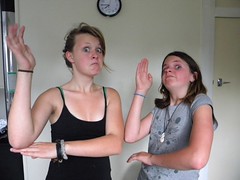“You have to buy new shoes,” I flatly inform my eldest as I stare at the wreckage of what used to be a lovely pair of black Keds.
Jaime wails, “Nooooo!! There are only two weeks left...” Her voice trails off at my frown.
“Yes,” I pick up her leg and poke my finger through the gaping hole in the bottom of her shoe. She writhes, struggles, and laughs as I mercilessly tickle her toes. “But these are not even technically shoes any more. The very definition of the word 'shoe' is violated by these objects.”
I'd like everyone reading this blog to now stop and subscribe to Freakonomics Radio, a podcast on the “hidden side of everything.” Stephen Dubner and his co-author Steven Levitt explore how economics so frequently results in unexpected outcomes due to the vagaries of human motivation. Their books Freakonomics and Superfreakonomics are must reads. The “law of unintended consequences” is particularly important in public policy, a hobby for which I actually have a graduate degree. When you craft a rule or law or tax, you want to get a specific outcome. However, strangely enough humans will often thwart the objective through some strange reasoning of their own. An example I'm particularly fond of is football helmets which paradoxically increase the severity of brain injuries in high school players by converting the head into a weapon and conferring a sensation of invulnerability to already immortal teenage youth.
Another story I enjoy is that of the economics professor using his children expermientally. His first attempt to potty train his eldest daughter had mixed results. She quickly learned that every time she could reliably produce an ounce of urine in the potty, she would get a candy. As a result, she developed phenomenally good bladder control to the point where she could pump out an ounce of pee every 20 minutes with clocklike precision. Undaunted by this somewhat dodgy result from his first attempt, the professor engaged the same child in an effort to potty train his son several years later. The reward was a candy every time she could successfully get her brother to use the potty. This time, his eldest was more sophisticated. She immediately mastered the basic concept of “what goes in must come out”.
Based on these anecdotal results, I suppose DrC and I should have predicted Jaime's shoes (and Aeron's stained shirts and Mera's shredded skirts) had we thought out our plans more carefully in the light of the professor's experience. But we didn't. Four years ago, we instituted a Clothing Allowance. We estimated our expenditure on clothes for each child, divided by twelve, and began to deposit the money directly into their personal bank accounts on the first of the month. We simultaneously vowed to never buy another article of clothing for any of the children ever again.
One happy, expected and successful result was a dramatic improvement in our mental well being in the check out line at major retail outlets. No more begging for this cute shirt or that colorful pair of socks as we made our way out of Costco with muffins, meat, and batteries. When a package of Dora panties appeared in the cart, a simple, “Okay, that'll be $9 from your account,” would result in their immediate return to the display counter without even so much as a whimper. I was delighted.
In point of fact, nothing appeared on the check out counter. Ever. The girls started shopping at the Salvation Army and Value Village. They haunted yard sales and descended like vultures on the bags of used clothes that appeared at the homeschool resource center. Aeron benefited from her sisters' hand-me-downs while Jaime started acquisitively eying my footwear and her father's sweats. Months passed, seasons changed, and the girls' attire slowly dissolved while their bank accounts grew.
Finally, one day they announced that they wanted to withdraw major sums of money from their accounts. We were visiting their grandmother in the States at the time, and the girls wanted to visit Costco. Secretly, their father and I were relieved. FINALLY, the girls were ready to replace their now completely destroyed wardrobes. Costco shirts, socks, panties, shorts and shoes would be perfect. If we were clever, we might even talk them into getting a sweat shirt or jacket. I pulled out the cash, passed it around, and piled them into the car inwardly pleased with the results of our economic experiment. The feeling of euphoria, however, was premature and woefully misplaced as two laptops and an iTouch appeared on the counter as we checked out.
“What?...WHAT?!” No clothes? No shoes? No cute little jacket?! I was incredulous.
Mera asked worriedly, “We have enough, right? I did the tax math...” her voice trailed off as I glared at her.
“Yes. You have enough.” Grimly, I waited out transactions. Bitten on the ass by my own cleverness, I marched out of Costco trailed by three children in see-through t-shirts, ragged hems, and holey socks lost in a discussion of what freeware to download first to their new toys.
Fast forward a year to this afternoon in Pukekohe and Jaime's disgraceful footwear. I am going to lose this argument; Jaime is saving for an iPad. Therefore, I have two choices: I can capitulate to her blackmail and “gift” my eldest daughter with a new pair of shoes, or I can put up with a call from her homeroom teacher every day for two weeks until school gets out. No doubt, in the United States we would be reported to Child Protective Services for child neglect. In New Zealand where shoes are not just optional but in elementary school actually forbidden from the classroom, the phone calls are extent of the harassment.
I drop Jaime's foot with a thud and throw up my hands, “Fine. Fine! I'll turn off my cell phone for two weeks.”



6 comments:
I don't know how you do it with three. shopping with/for one daughter has me ready to stab myself in the eye with an icicle. Holey ragged ready for the rubbish bin clothing is actually my style. My daughters 37 outfit coordinated PURSES have me convinced there was a mixup at the nursery.
I have hand-me-downs for you!!! Prom dresses when the time comes. My daughter had all the girly stuff that they dream about in Jr. High and High School. Now 10 years later she's a Schooner Chic shopping at Good Will. I see nothing wrong with the way you are teaching them to handle their money, it's really great! And I love the idea of shoes being optional or forbidden in the classrooms... I work at an Elementary School. I'd be the first one to show up barefoot.
I am crying as I read this - this sounds SO familiar.
- SteveF
You can always start imposing a tax on non-clothing items...I think that one turned out really well for the economics professor!
Loved this post since we've gone through the clothing allowance with 2 of our 5 kids so far.
Fortunately we didn't get snookered at the end because we had a rule that the clothing allowance - held in a virtual Bank of Mom & Dad account - was use-it-or-lose-it on clothing. I.e., we delivered the budgeted sum annually and any unused portion was zeroed out at the end of the year.
We seemed to have escaped unintended consequences so far, but we still have 3 more to put through the system ;-)
The Haka face is just total awesomeness!
Post a Comment